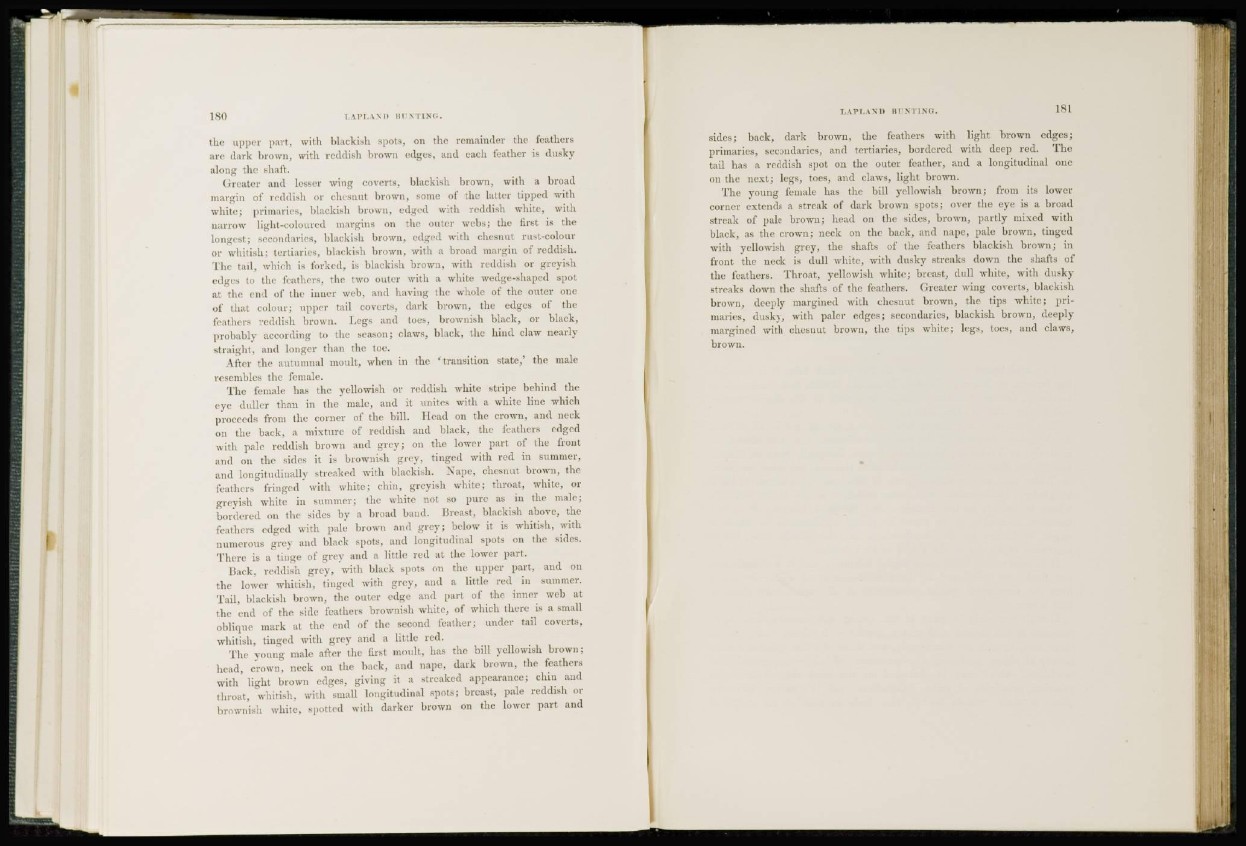
the upper part, with blackish spots, on the remainder the leathers
arc dark brown, with reddish brown edges, and each feather is dusky
along the shaft.
Greater and lesser wing coverts, blackish brown, with a broad
margin of reddish or chesnut brown, some of the latter tipped with
white; primaries, blackish brown, edged with reddish white, with
narrow light-coloured margins on the outer webs; the first is the
longest; secondaries, blackish brown, edged with chesnut rust-colour
or whitish; tertiaries, blackish brown, with a broad margin of reddish.
The tail, which is forked, is blackish brown, with reddish or greyish
edges to the leathers, the two outer with a white wedge-shaped spot
at the end of the inner web, and having the whole of the outer one
of that colour; upper tail coverts, dark brown, the edges of the
feathers reddish brown. Tegs and toes, brownish black, or black,
probably according to the season; claws, black, the hind claw nearly
straight, and longer than the toe.
After the autumnal moult, when in the 'transition state/ the male
resembles the female.
The female has the yellowish or reddish white stripe behind the
eye duller than in the male, and it unites with a white line which
proceeds from the corner of the bill. Head on the crown, and neck
on the back, a mixture of reddish and black, the feathers edged
with pale reddish brown and grey; on the lower part of the front
and on the sides it is brownish grey, tinged with red in summer,
and longitudinally streaked with blackish. Nape, chesnut brown, the
leathers fringed with white; chin, greyish white; throat, white, or
greyish white in summer; the white not so pure as in the male;
bordered on the sides by a broad band, breast, blackish above, the
feathers edged with pale brown and grey; below it is whitish, with
numerous grey and black spots, and longitudinal spots on the sides.
There is a tinge of grey and a little red at the lower part.
Back, reddish grey, with black spots on the upper part, and on
the lower whitish, tinged with grey, and a little red in summer.
Tail, blackish brown, tin; outer edge and part of the inner web at
the end of the side feathers brownish white, of which there Ís a small
oblique mark at the end of the second feather; under tail coverts,
whitish, tinged with grey and a little red.
The young male after the first moult, has the bill yellowish brown;
head, crown, neck on the back, and nape, dark brown, the feathers
with light brown edges, giving it a streaked appearance; chin and
throat, whitish, with small longitudinal spots; breast, pale reddish or
brownish white, spotted with darker brown on the lower part and
sides; back, dark brown, the feathers with light brown edges;
primaries, secondaries, and tertiaries, bordered with deep red. The
tail has a reddish spot on the outer feather, and a longitudinal one
on the next; legs, toes, and claws, light brown.
The young female has the bill yellowish brown; from its lower
corner extends a streak of dark brown s p o t s ; over the eye is a broad
streak of pale brown; head on the sides, brown, partly mixed with
black, as the crown; neck on the back, and nape, pale brown, tinged
with yellowish grey, the shafts of the feathers blackish brown; in
front the neck is dull white, with dusky streaks down the shafts of
the feathers. Throat, yellowish white; breast, dull white, with dusky
streaks down the shafts of the feathers. Greater wing coverts, blackish
brown, deeply margined with chesnut brown, the tips white; primaries,
duskv, with paler edges; secondaries, blackish brown, deeply
margined with chesnut brown, the tips white; legs, toes, and claws,
brown.